
Port Macquarie, locally nicknamed Port, is a coastal city the local government area of Port Macquarie-Hastings. It is located on the Mid North Coast of New South Wales, Australia, about 390 km (242 mi) north of Sydney, and 570 km (354 mi) south of Brisbane. The city is located on the Tasman Sea coast, at the mouth of the Hastings River, and at the eastern end of the Oxley Highway (B56). The city with its suburbs had a population of 47,973 in June 2018 and an estimated population of 50,307 in June 2023.
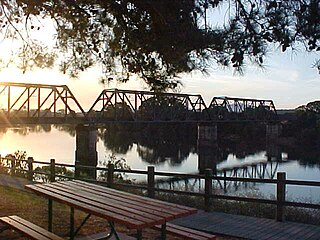
Hastings River, an open and trained intermediate wave dominated barrier estuary, is located in the Northern Tablelands and Mid North Coast districts of New South Wales, Australia.
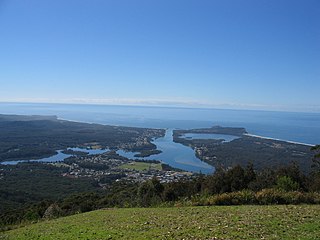
Laurieton is a coastal town on the Mid North Coast of the Australian state of New South Wales. Laurieton is the largest town in the Camden Haven district. Laurieton is 365 km north of Sydney and 42 km south of Port Macquarie. It lies between the base of North Brother Mountain and the Camden Haven River. At the 2016 census, it had a population of 1,986.
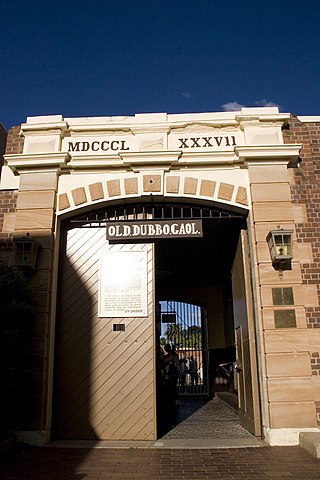
The Old Dubbo Gaol is a heritage-listed former gaol and now museum and tourist attraction at 90 Macquarie Street, Dubbo in the Dubbo Regional Council local government area of New South Wales, Australia. The gaol was designed by the NSW Colonial Architect's Office and was built from 1847 to 1945 by James Atkinson Jnr (1862–63) and William Bonython Moffatt. The gaol is also known as the Dubbo Jail and the Dubbo Gaol. The building was added to the New South Wales State Heritage Register on 26 March 2004. The building was the second gaol in Dubbo, replacing lockups built in 1847 and 1862.

Bridge Street is a street in the central business district of Sydney in New South Wales, Australia. Bridge Street runs for 500 metres (1,600 ft) in a west–east direction with traffic flowing in both directions. It is situated in the northern portion of the central business district. The western terminus of Bridge Street is at George Street, with the eastern terminus at Macquarie Street, adjacent to the Chief Secretary's Building. From west to east, Bridge Street crosses Pitt and Phillip streets.

The First Government House was the first residence for the Governors of New South Wales located at 41 Bridge Street, in the Sydney central business district in the City of Sydney local government area of New South Wales, Australia. It was built from 1788 to 1789 and used until 1845, after which it was demolished in 1846. Some of the site is now occupied by the Museum of Sydney. Its construction was attributed to James Bloodsworth. It is also known as First Government House Site, Museum of Sydney and A Rum Rebellion Site. It was added to the New South Wales State Heritage Register on 10 December 1999; and on 19 August 2005 the site was listed on the National Heritage List.

Loder House is a heritage-listed residence at 126 George Street, Windsor, City of Hawkesbury, New South Wales, Australia. It was built in 1834. It has been used at times for various other purposes: as a bank, multiple restaurants, a guesthouse and a bookshop. It was added to the New South Wales State Heritage Register on 2 April 1999.

The Old Government Cottages Group consists of two heritage-listed houses at 16 Stanley Street and 1 George Street, Bathurst, Bathurst Region, New South Wales, Australia. The group was built from 1837 to 1860. The buildings are also known as 'Old Government House', Macquarie House, Miss Falloon's cottage and John Ford's house. The property is owned by Bathurst Regional Council. It was added to the New South Wales State Heritage Register on 21 February 2003.

Coutt's Sailors Home is a heritage-listed former sailor's home, health clinic, government office building and now residence at 16 Bond Street, Newcastle, City of Newcastle, New South Wales, Australia. It was designed by George Brown and built in 1882 by Robert Muirhead. It is also known as Coutt's Sailors Rest Home. It was added to the New South Wales State Heritage Register on 22 March 2011.
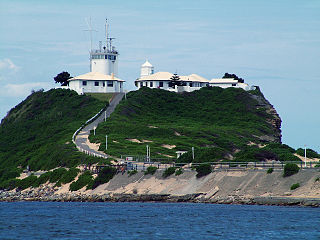
Coal River Precinct is a heritage-listed historic precinct at Nobbys Road, Newcastle, New South Wales, Australia. It was built from 1804 to 1960. It includes Fort Scratchley, Nobbys Head, the Convict Lumber Yard site, Macquarie Pier, the breakwater and Nobby's Beach. It was added to the New South Wales State Heritage Register on 19 December 2003.
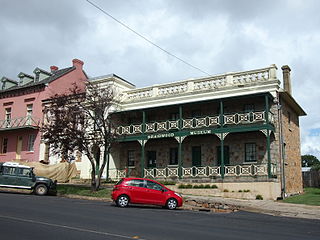
Braidwood District Historical Society Museum is a heritage-listed former hotel and Oddfellows Hall and now museum at Wallace Street, Braidwood, Queanbeyan-Palerang Region, New South Wales, Australia. The property is owned by Braidwood Historical Society. It was added to the New South Wales State Heritage Register on 2 April 1999.

Old Port Macquarie Courthouse is a heritage-listed former courthouse and now justice museum at Clarence Street (cnr), Port Macquarie, Port Macquarie-Hastings Council, New South Wales, Australia. It was designed by James Barnet and built in 1869 by Butler and Bourne. It was added to the New South Wales State Heritage Register on 2 April 1999.

Port Macquarie First Burying Ground is a heritage-listed former cemetery and now public park at Clarence Street, Port Macquarie, Port Macquarie-Hastings Council, New South Wales, Australia. The site was chosen by Captain Allman, and it was in use from 1822 to 1824. It is also known as Allman Hill Burying Ground, Port Macquarie Burying Ground and Old Port Macquarie Cemetery. The property is owned by Port Macquarie-Hastings Council. It was added to the New South Wales State Heritage Register on 1 July 2005.

Port Macquarie Second Burying Ground is a heritage-listed former cemetery at Gordon Street, Port Macquarie, Port Macquarie-Hastings Council, New South Wales, Australia. It was in use from 1824 to 1886. The property is owned by Port Macquarie-Hastings Council. It was added to the New South Wales State Heritage Register on 1 July 2005.

St Thomas' Anglican Church is a heritage-listed Anglican church at Hay Street, Port Macquarie, Port Macquarie-Hastings Council, New South Wales, Australia. It was built from 1823 to 1827 by convict labour under military supervision. The property is owned by the Anglican Diocese of Grafton. It was added to the New South Wales State Heritage Register on 18 October 2002.

Port Macquarie Government House Site is a heritage-listed archaeological site at 2 Clarence Street, Port Macquarie, Port Macquarie-Hastings Council, New South Wales, Australia. It was built from 1824 to 1826 by convict labour. The property is owned by Port Macquarie-Hastings Council. It was added to the New South Wales State Heritage Register on 3 August 2001.
Overseers' Cottages Remains is a heritage-listed archaeological site, now incorporated into the Glasshouse entertainment centre, at 30-44 Clarence Street, Port Macquarie, Port Macquarie-Hastings Council, New South Wales, Australia. It is the remains of cottages for convict overseers', built from 1823 to 1830 by convict labour. The property is owned by Port Macquarie-Hastings Council. It was added to the New South Wales State Heritage Register on 13 August 2010.

Macquarie Arms Hotel is a heritage-listed hotel at Thompson Square, Windsor, City of Hawkesbury, New South Wales, Australia. It is also known as the Royal Hotel. It was added to the New South Wales State Heritage Register on 2 April 1999.

Windsor Court House is a heritage-listed courthouse at Court and Pitt Streets, Windsor, City of Hawkesbury, New South Wales, Australia. It was designed by Francis Greenway with a later extension by James Barnet and built from 1821 to 1822 by William Cox. It was added to the New South Wales State Heritage Register on 2 April 1999.
Parramatta Archaeological Site is a heritage-listed urban facility at 45 Macquarie Street, Parramatta, City of Parramatta, New South Wales, Australia. It is also known as Archaeological Site and Associated Artefacts and V by Crown; 45 Macquarie Street; Wheatsheaf Hotel & Convict Hut Archaeological Site; Foundry/Blacksmithy; Industrial Archaeological Site. The property is privately owned. The site was added to the New South Wales State Heritage Register on 5 July 2019.


















